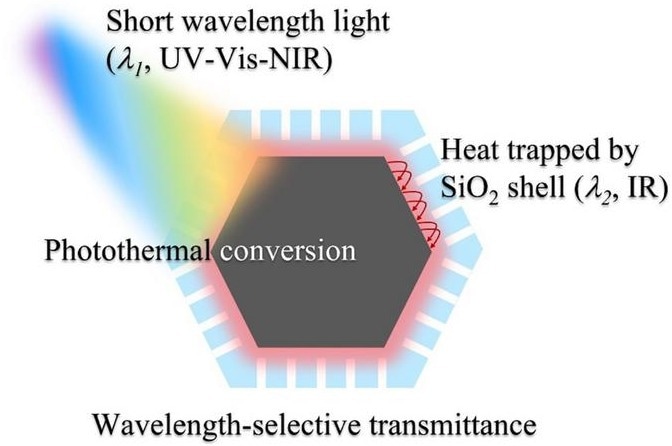An effective method for turning waste plastic into valuable chemicals is photothermal catalysis, which is powered by clean solar energy. By using a catalytic process, solar energy can be captured and transformed into chemical energy. However, there are several obstacles to overcome to create photothermal catalysts with high catalytic activity and conversion efficiency.
 Inspired by the warming Earth’s greenhouse effect, we design a catalyst architecture that enables waves selectively to pass through. This greenhouse mimic is composed of a carbonized MOF core with a mesoporous silica sheath. When bathed in sunlight, the black core generates heat, which is trapped therein by the infrared shielding effects of the mesopores, thus boosting the recycling efficiency of waste plastics. Image Credit: Chinese Journal of Catalysis
Inspired by the warming Earth’s greenhouse effect, we design a catalyst architecture that enables waves selectively to pass through. This greenhouse mimic is composed of a carbonized MOF core with a mesoporous silica sheath. When bathed in sunlight, the black core generates heat, which is trapped therein by the infrared shielding effects of the mesopores, thus boosting the recycling efficiency of waste plastics. Image Credit: Chinese Journal of Catalysis
A study team from Soochow University in China, under the direction of Prof. Jinxing Chen, has made a significant discovery. They have successfully created an integrated photothermal catalyst made of c-ZIF-8 that has been covered in a layer of SiO2.
By limiting thermal radiation loss and boosting the catalyst’s localized heating impact, this novel technique aims to improve catalytic activity. Chinese Journal of Catalysis reported the findings.
The production of ZIF-8 nanoparticles via a template technique is the innovative catalyst design strategy introduced in this study. The surface of ZIF-8 is covered with SiO2, and then high-temperature carbonization is used to form an integrated photothermal catalyst (c-ZIF-8@SiO2).
The exterior SiO2 layer of the catalyst selectively permits solar light to pass through, and the inside carbon material in the catalyst absorbs solar energy and produces heat.
With this design, the internal carbon core’s thermal radiation loss is successfully reduced, and the local thermal impact during photothermal catalysis is improved. The SiO2 shell also has a shielding effect, contributing to the catalyst’s great stability.
Overall, the creation of effective photothermal catalytic systems can profit from the use of this catalyst design technique, which provides a universal method for improving the local thermal impact in photothermal catalysis.
The c-ZIF-8@25SiO2 catalyst effectively converts PET into useful monomers when exposed to sunlight. The selective recovery of PET from mixed plastics and the PET glycolysis experiment conducted in direct sunlight serve as additional examples of possible uses for photothermal catalytic PET glycolysis.
In addition to encouraging green and sustainable development by reducing emissions and conserving energy, photothermal catalysis also offers fresh perspectives and strategies for effective chemical recycling of plastics.
Journal Reference:
Lou, X., et al. (2023) Highly efficient photothermal catalytic upcycling of polyethylene terephthalate via boosted localized heating. Chinese Journal of Catalysis. https://doi.org/10.1016/S1872-2067(23)64435-3